








By Justin Kim
Young people often do not know what they do not know. Thus when God calls them to do something, they say yes. This is why the Lord utilizes young people to carry out that which is audacious. He utilized young adults in the early church, during the Reformation, through various church movements, in the international missionary organizations, and at the beginning of the Advent movement.
It was in 1848 when the Lord instructed Ellen and James White, with a group of young adults in their late teens and early 20s from the northeastern United States, to start a publication that would go throughout the world. How would they accomplish this? How would it get around the world? Where would the finances come from? Rather than being weighed down with anxiety, they set forth in fearless faith in launching what you’ll read about in this issue: the “streams of light” “clear round the world.”
The imagery of “streams” denotes linear bodies of water in constant motion with dynamicity. They provide cleansing to that which is polluted, moisture to places rocky and uninhabited, and precious life to the desert. Streams are found emanating from the City of God (Ps. 46:4), but also out of the rock in the wilderness (Ps. 78:16, 20). Streams also point to living, or moving, water. Not stagnant or stale, these flowing watercourses point to vitality, movement, and energy.
Ted N. C. Wilson
22 Discovering the Spirit of Prophecy Philanthropy and Mission Hebe Soares
24 Feature
26 Bible Questions Answered
27 Health & Wellness
28 May I Tell You a Story? Keep Choosing Kindness
30 Growing Faith The “Killer” Dog

“Streams” are combined with the imagery of “light.” Whereas fire causes heat with the possibility of pain, light shines forth in its innocence. It debuts in Scripture with the ability to divide and separate darkness. Each morning, light ends the blackness of night while commencing the newness of each day. It accompanied the children of Israel through the wilderness and continues to accompany us in Scripture (Ps. 119:105) until we get to our Canaan. And just like streams, “light” points to a certain dynamism that grows in volume and intensity (Prov. 4:18).
These fluid lines of radiance were to go around the world. How a daring group of youth thought they could reach the whole world is a testament to their faith. After 175 years of the Adventist Review ministry, including the birth of Adventist World, we can look back and see that it was God who inspired, God who directed, and God who empowered. And we know God will continue to see these “streams of light” continue to reverberate. As we navigate these streams, pray with us that this ministry will continue to uphold the Water of Life and the Light of the World to the whole world.

The PNG for Christ initiative drew thousands of people to more than 2,000 sites spread throughout Papua New Guinea. More than 300,000 people have been baptized as a result of the evangelistic event, which took place from April 26 to May 11.
The number of people that were baptized following an evangelistic meeting that was held simultaneously in 11 locations across the province of Agusan del Sur, Philippines, May 19-24. The event was organized by Adventist World Radio along with its Center for Digital Evangelism. The center’s involvement highlights the power of using mass media as a powerful tool in sharing the gospel. The media ministry work directly contributed to the success of the meetings, and church leaders have observed that through the media ministry the Southeastern Caraga Mission has experienced significant growth.
“We want to revive and renew the missionary spirit throughout the SPD. As a diverse division, we need to keep working with different cultures to foster mutual understanding and growth.”
—Glenn Townend, president of the South Pacific Division (SPD), about the partnership between the SPD and the Southern Asia-Pacific Division. This partnership aligns with the broader Mission Refocus initiative announced by the General Conference in 2022 to reignite the Adventist Church’s commitment to worldwide evangelism and outreach.
The number of Adventurers, parents, teachers, and leaders that attended the first Adventurer Fair hosted by the Gulf Field, located in Ras Al Khaimah, United Arab Emirates. Fairs allow club members to create friendships with members of other clubs and it gives them a chance to see that they belong to a larger organization.
Church members were asked how often during the past 12 months they helped with a church ministry.
“It warmed my heart to hear the powerful stories from the ELIA partners who are using the ELIA tool kit to meet the needs of the community and build relationships with them so they can live their best life now and for eternity.”
—Geraldine Przybylko, executive director of ELIA Wellness and South Pacific Division Adventist Health strategy leader, during the 2024 Empowering Lifestyle Innovation and Advocates (ELIA) Wellness Summit, held May 24-26 on the Gold Coast of Queensland, Australia. The summit featured the latest insights into lifestyle medicine and compelling community impact. More than 170 health leaders from Australia, New Zealand, Papua New Guinea, and Fiji attended the event. The summit took place on the Gold Coast to promote the local conference’s strategic goal of setting up 50 ELIA Wellness hubs by 2025.
Involvement before the pandemic
10% More than once a week
19% Every week
13% Almost every week
9% Once a month
9% At least once a quarter
16% Only once or twice
24% Never
N=147,337
Source: 2022-23 Global Church Member Survey
Data provided by the General Conference Office of Archives, Statistics, and Research
Would you like to keep up with what’s happening in our church? Sign up today to receive our weekly newsletter that features news stories, inspirational stories, videos, and more.
www.adventistreview.org/ newsletter-signup
“Today we are here because we no longer wish to be spectators on the landscape of historical and emerging conflicts, but actors on the world stage to bring about meaningful peaceful solutions.”
—Catherine Anthony Boldeau, former communication and engagement lead for Adventist Development and Relief Agency United Kingdom (ADRA-UK), during the Faith in Peace event held in the Churchill Room at the House of Commons in Westminster, London, United Kingdom, on May 20. The event was organized by ADRA-UK and hosted by Watford Member of Parliament Dean Russell and was attended by 82 guests. The event was the first of a week of celebrations to mark ADRA-UK’s fortieth year as a nongovernmental organization.
“The caravans are very important for Novo Tempo Network, as they are a unique opportunity that we have as a broadcaster to have a direct meeting with our viewers with part of our group of presenters. We have the joy of bringing together thousands at the same time . . . and strengthening this direct relationship with them.”
—Antonio Tostes, TV Novo Tempo Network general director, about the first two caravans that took place so far this year in Pará and Maranhão in northern Brazil. On Sabbath, May 18, in Marabá, Pará, the team presented mini programs, such as Family Clinic, Bible Goodness, Easy Bible, In the Sights of Truth, and many more. The event welcomed about 1,500 people. The following day the team traveled to the city of Imperatriz, Maranhão, and presented to a crowd of about 1,200 people.
The number of college and university students and professionals that gathered in Montserrat, Barcelona, Spain, from May 3 to 5, to celebrate the fiftieth anniversary of the Association of Adventist University Students and Graduates in Spain. For the past 50 years this group has provided a secure context for students and graduates to ask questions and discuss perspectives as well as to strengthen each other’s faith. During the past decade this association has been working together with the local conference’s youth department to prepare Adventist upper high school students for the rigors of a dominant atheistic academic environment at state universities and to help them preserve their Adventist faith.

Escrito Está, the Spanish-language ministry of It Is Written, marks 30 years of ministry in 2024 year. Created to reach the Spanish-speaking world, Escrito Está filmed its first program on April 5, 1994, with Milton Peverini as host. Peverini, who for many years had been a leader in media evangelism, worked with It Is Written to produce Spanish programs and songs, which began airing on cable channels in 1995 in the United States.
In the fall of 1996 Escrito Está debuted nationwide in Chile to a phenomenal response, and other countries quickly followed as the quality and message of this Spanish-language programming touched thousands of lives. Today Escrito Está ministers around the world.
Robert Costa joined the ministry in 2002 to coordinate evangelism campaigns, taking over from Peverini as speaker/director in 2006.
“The thirtieth anniversary is a special occasion when we remember that God has led us so far,” Costa said. “Thirty years is a real miracle, but the greatest of miracles are those hearts that are transformed by the power of the Holy Spirit. For 30 years God has used Escrito Está to be part of His mission around the world.”
Escrito Está is currently the most widely aired Spanish-language television program of the Seventh-day Adventist Church. Today it has a prominent presence on national television stations in several Latin American countries. One major television network in a populous South American country airs no religious programming except for Escrito Está. When Escrito Está was aired in one Central American country, the owner of the channel was so impressed with the programming that he expanded the
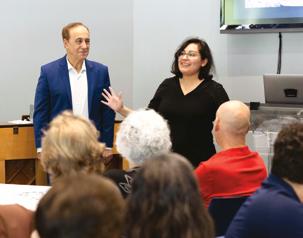
Created to reach people in North America, it has grown to other world regions.
broadcast to be nationwide and increased it from once a week to twice a week—at no extra charge. The resulting increase in Bible study interests meant the church had to employ additional staff to process the requests.
“Media has no limits, and the gospel has no barriers,” Costa said. “So far we have viewers from 142 countries. As the Bible says, this gospel will be preached to all nations, all languages, all people. I’m so glad that Escrito Está and It Is Written are part of the fulfillment of this prophecy.”
In addition to its flagship program, Escrito Está produces two other ongoing programs and conducts about 15 evangelism campaigns worldwide every year, resulting in thousands of baptisms annually. Additionally, Costa participates in camp meetings, rallies, and evangelism training for pastors and lay members. Meetings are held in venues of all sizes, from small churches to stadiums, where the messages are livestreamed across the country. In some countries Costa joins a caravan, where he preaches every night in a different city.
Over the years God has reached people at every level of society through the ministry of Escrito Está, including government leaders, pastors from other denominations, television personalities, people living in the Amazon jungle, and even those in hard-to-reach places, such as China and Muslim countries.
“As we look forward to Jesus’ soon return,” Costa said, “it’s great to be part of the final movement to tell the whole story to the whole world.”
Marcos Paseggi, Adventist World

The communication and AV teams setting up large speakers along Ela Beach in Port Moresby, Papua New Guinea, on Friday night, May 10, tested the equipment and wrapped up around 4:00 a.m. on May 11. By then, still in the dark of the night, the first Seventh-day Adventist church members were arriving for a massive baptismal ceremony scheduled to start at 7:00 a.m. Many walked for miles, and others used private vehicles, chartered transportation, and several other means to reach the place of the ceremony in time.
“There are 5,000 people waiting to be baptized,” organizers said, “and we must finish before noon, when the low tide will make baptism by immersion impossible.”
By the time the ceremony started, thousands of candidates, church members, leaders, and guests were already lining up and sitting on the wave breakers on both ends of the beach. The first 12 pastors began to baptize as regional church leaders prayed over the loudspeakers for those committing to God through
the biblically mandated ceremony. A couple hours later 48 pastors were baptizing candidates. By 11:00 a.m. the ceremony was finished.
The baptism in the ocean was one of the ceremonies that crowned the last official day of the PNG for Christ 2024 evangelistic series. The project combined the efforts of Adventist World Radio, the Total Member Involvement initiative, the South Pacific Division, the Papua New Guinea Union Mission, and local church fields to share the gospel across the country. According to organizers, international and national speakers preached at more than 2,000 sites.
The April 26-May 11 series served as a “reaping campaign,” during which participants shared the joy of welcoming thousands of new members after months of reaching out to their neighbors and friends to study the Bible. Adventist radio and TV also supported the work of hundreds of pastors, lay church members, and Bible instructors on the ground.
The May 11 baptism on Ela Beach was one of many concurrent closing ceremonies but probably the largest. The event required an impressive logistical organization that involved hundreds of regional church leaders, local church pastors, elders, deacons and deaconesses, and other volunteers.
As the baptism unfolded, deacons and deaconesses helped on the beach, leading candidates in long lines toward the water. Other deacons stayed in the water, helping candidates to get to the pastors baptizing them and leading them back to the shore. Deaconesses waited on the shore with towels and flower garlands to embrace those baptized.
On one side of the beach, a pastor said a prayer over the loudspeakers every time pastors on the distant water showed by raising their hand that they were ready to baptize another candidate. Church choirs provided special musical items in between, which were broadcast through the generator-powered speakers along the shore and beyond.
“This is a spiritual feast,” a church member commented, “a spiritual feast as we have never seen.”
After the ceremony was done, there was still a lot of work to do for the massive group of volunteers.
“At least it’s the last day. Tomorrow you will finally be able to rest,” one of the visiting guests said to a local church member.
“Tomorrow?” he answered. “Tomorrow we are launching our retention program for the new converts!”
The Seventh-day Adventist Church in Jamaica, through its Possibility Ministries, donated 10 wheelchairs to the Jamaica Council for Persons With Disabilities at a special Assistive Technology and Health Symposium, held recently at the Andrews Memorial Seventh-day Adventist Church in Kingston. The initiative was a collaborative effort between the Jamaica Union Conference, Andrews Memorial Hospital, and Adventist-laymen’s Services and Industries (ASi).
In making the presentation on behalf of the church, Levi Johnson, secretary of the Jamaica Union, addressed the audience. “Even before the Seventh-day Adventist Church as a whole gave its stamp of approval to Possibility Ministries, Pastor Everett Brown, president of the Jamaica Union, along with church leaders, made the decision not only to take one day to recognize the work of Possibility Ministries but to take an entire week,” he said.
“That was a bold move by our union president,” Johnson added, noting that at the time, the ministry
was in its infancy. “The entire world is learning from the Jamaica Union.”
In relating the history of Possibility Ministries in Jamaica, Adrian Cotterell, Possibility Ministries director in Jamaica, said, “We launched what was then called special needs ministries in 2015. When we launched, our president, Pastor Everett Brown, made a solemn proclamation that every second week of March would be celebrated as Possibility Ministries week, when we would show to the world our love for this ministry and that people are valued.”
One year later the union established the first Deaf church in the Inter-American Division territory, and the church launched the annual Assistive Technology and Health Symposium to provide hearing devices, Cotterell explained. “We view disabilities through the transforming lens of possibilities, potentials, abilities, capacities, and skills and what we can do and become through the grace of Jesus,” he said.
Cotterell told the gathering that the Seventh-day Adventist Church
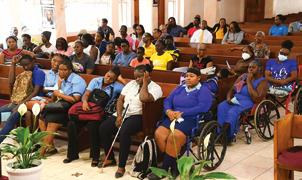
Initiative brings transformative change to people with disabilities.
in Jamaica has given out 50 wheelchairs annually during the past few years at a cost of more than JA$25 million (about US$160,000).
“This year we are partnering with Andrews Memorial Hospital to give out another 150 wheelchairs, totaling more than JA$9 million [about US$57,000],” he added. The ministry has also distributed dozens of walkers, crutches, canes, computers, and gift vouchers every year.
During his address to the gathering, Donmayne Gyles, CEO of Andrews Memorial Hospital, commended regional leaders of the Adventist Church’s East Jamaica Conference and the Jamaica Union for collaborating with them in their eightieth year of impacting lives in Jamaica.
“This collaborative event signifies the coming together of faith, compassion, and service to our community,” Gyles said. “The whole concept is aimed at bringing hope, healing, and transformative change to individuals in need within our society. I believe I can say without a shadow of a doubt that this is a testament to our shared commitment to making a positive impact upon the lives of others.”
In his devotional charge, Nigel Coke, communication director of the Jamaica Union, said that “caring for the blind, the physically immobile, those who have mental health challenges, orphans, vulnerable children, and those mourning the loss of a spouse and support of caregivers is not an option for the Seventh-day Adventist Church but an imperative.” He reminded his audience that the poor are placed among us “to test our compassion, and we must always show kindness.”

Photo: Damáris Gonçalves
Event draws 20,000 young people for training, outreach, and inspiration.
Almost 20,000 Seventh-day Adventist young people from across the South American Division (SAD) gathered in Brasilia, Brazil, for the Maranatha Youth Convention May 29June 1. Young church members and their leaders from the eight countries comprising the SAD met at the Mané Garrincha BRB Arena for several days of Bible preaching, workshops, exhibits, and outreach activities.
The convention required major logistical arrangements, as 18,000 young people camped outside the arena on the parking area. The setup included showers and restroom facilities, and two outdoor restaurants that served more than 50,000 meals per day.
On May 29 the opening ceremony reflected on decades of
Adventist youth convocations and reviewed some of the theme songs composed for those events. A common thread through most of those songs is the desire of trusting and imitating Jesus, and the commitment to surrender to be His witnesses, serving Him through serving others as He sees it best.
“You have come here because there’s a very powerful calling beating in you,” SAD youth director Carlos Campitelli told the participants sitting in the stadium stands. “That calling runs through your veins, and you well know that it cannot be ignored. It is the reason you are a Seventh-day Adventist young person. And in the last days of this earth’s history God has set you apart for a very special mission, which is to reflect His image.” He added, “By being here, you are telling Him, ‘Here I am, Lord. Everything I am, everything I have, is Yours. Now use me.’ ” Stanley Arco, president of SAD, explained the rationale behind the convention. “We dreamed of this because our goal is ‘all of your people can be saved,’ ” he said. “And to be saved, every one of you needs to develop a personal relationship with Jesus, and then share that with all those around you. Our dream is for each one of you to be-
come a missionary, someone who may take other people to Jesus, who may live out and show Jesus in their life.”
The keynote speaker on May 29 was Elbert Kuhn, General Conference director of Adventist Volunteer Service. Kuhn invited participants, “Discover God’s will and purpose for your life tonight.”
Quoting American writer Mark Twain, he said, “There are two significant days in your life. First, the day you are born, and second, the day you find out the reason you were born.”
In the next few minutes, Kuhn called the Adventist young people to embrace “a mission that even angels would love to have,” that is, to “place all the gifts and talents that God has endowed you with to be a blessing and to make a difference in this world.”
Kuhn emphasized that while there are many things they can’t do to change the current state of this world, there’s something they can do: “Decide to become part of a prophetic movement,” placing “all of our lives, talents, creativity, resources, and everything He has given us to bless other people, being God’s own face for them.”
In 1949 the book Origin and History of Seventh-day Adventists was printed, and included this painting as well as several others by Harry Anderson. It is believed these illustrations were first commissioned for inclusion in this book.
Harry Anderson, a gifted young artist, worked on advertising campaigns for a long list of American companies. In 1944 he and his wife converted to Adventism. While he did not give up his commercial work, he did begin to produce artwork with religious themes, eventually creating about 300 illustrations for the Review and Herald Publishing Association. The illustration to the right is the artist’s rendition of Ellen White’s vision of the publishing work in 1848. Seated behind Ellen White are James White (left) and Joseph Bates, both of whom were present for the vision. Bates is shown taking notes of the words she spoke while in vision. The world above and to the right depicts the streams of light that would eventually encircle the globe because of the publishing work.


Nothing could hinder the vision’s fulfillment
As the early Adventist pioneers began to discover biblical truths such as Jesus’ work in the Heavenly Sanctuary and the seventh-day Sabbath, they often gathered to study together and pray. They were strongly impressed that they needed to share this information with others. But how? It was during a series of conferences specifically related to the Sabbath that an unexpected solution emerged.
•
“It was shortly after the fifth . . . Sabbath conference held in 1848 that another meeting was called at the home of Otis Nichols in Dorchester (near Boston), Massachusetts. The brethren were studying and praying concerning their responsibility to herald the light that the Lord had caused to shine upon their pathway. As they studied, Ellen White was taken off in vision, and . . . she was shown the duty of the brethren to publish this light. She recounts the incident in Life Sketches:
“ ‘After coming out of vision, I said to my husband: “I have a message for you. You must begin to print a little paper and send it out to the people. Let it be small at first; but as the people read, they will send you means with which to print, and it will be a success from the first. From this small beginning it was shown to me to be like streams of light that went clear round the world” ’ (p. 125).
“Here was a call to action. What could James White do? He had little of this world’s goods. But the vision was a divine directive, and he felt the compulsion to move forward by faith. So with his
“I was shown that we must continue to publish, and the Lord would sustain us.”
the publishing work of the Seventh-day Adventist Church began.”1
The Whites traveled extensively but still managed to print issues of The Present Truth. It was while they were staying with the Harris family in Auburn, New York, that they added a second, longer paper to their publishing work. It was a monthly magazine they called the Advent Review. This was not The Advent Review and Sabbath Herald that would later come, but another paper they sent to believers in between issues of The Present Truth.
My husband said he would go to Port Byron for the proof sheets. We helped him harness the horse, and I accompanied him. The Lord strengthened him on the way. He received his proof, and a note stating that the paper would be off the press the next day, and we must be at Auburn to receive it.
seventy-five cent Bible and concordance with both covers torn off, James White began to prepare the articles on the Sabbath truth and other kindred topics to be printed in a little paper.
“All this took time, but eventually he presented the copy to a printer in Middletown, Connecticut, who was willing to trust him for the printing order. The type was set, the proofs were read, and one thousand copies of the paper were printed.
James White transported them from the Middletown printing office to the Belden home where he and Ellen had found a temporary refuge.
“The little sheet was six by nine inches [15.2 x 22.9 cm.] in size and contained eight pages. It bore the title The Present Truth. The date was July 1849. The little pile of papers was laid upon the floor. Then the brethren and sisters gathered about them and with tears in their eyes pleaded with God to bless the little sheet as it should be sent out. Then the papers were folded, wrapped, and addressed, and James White carried them eight miles [12.9 km.] to the Middletown post office. Thus
James White introduced the new 48-page paper this way: “Our design in this review is to cheer and refresh the true believer, by showing the fulfillment of prophecy in the past wonderful work of God, in calling out, and separating from the world and nominal church, a people who are looking for the second advent of our dear Saviour.”2
In November 1850 the believers held a conference in Paris, Maine. One of the topics for discussion was the growing publishing work. After some consideration, they decided to expand the paper and settled on an appropriate name: The Advent Review and Sabbath Herald 3
Ellen White recalls a series of events that occurred while lodging with the Harris family—attacks certainly intended to hinder the work they had just started.
“We were to go to Port Byron to read the proof sheets of the paper that was being printed at Auburn. It appeared to us that Satan was trying to hinder the publication of the truth which we were laboring to place before the people. We felt that we must walk out upon faith.
“That night we were awakened by the screams of our little Edson, who slept in the room above us. It was about midnight. Our little boy would cling to Sister Bonfoey [a friend and companion to the Whites], then with both hands fight the air, and then in terror he would cry, ‘No, no!’ and cling closer to us. We knew this was Satan’s effort to annoy us, and we knelt in prayer. My husband rebuked the evil spirit in the name of the Lord, and Edson quietly fell asleep in Sister Bonfoey’s arms, and rested well through the night. Then my husband was again attacked. He was in much pain. I knelt at the bedside and prayed the Lord to strengthen our faith. I knew God had wrought for him and rebuked the disease; and we could not ask Him to do what had already been done. But we prayed that the Lord would carry on His work. We repeated these words: ‘Thou hast heard prayer. Thou hast wrought. We believe without a doubt. Carry on the work Thou hast begun!’ Thus for two hours we pleaded before the Lord; and while we were praying, my husband fell asleep, and rested well till daylight. When he arose he was very weak. . . .
“We trusted the promise of God and determined to walk out by faith. We were expected at Auburn that day to receive the first number of the paper. We believed that Satan was trying to hinder us, and my husband decided to go, trusting in the Lord. Brother Harris made ready the carriage, and Sister Bonfoey
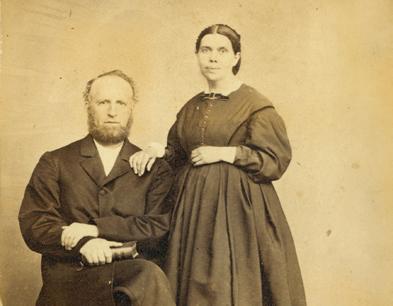

accompanied us. My husband had to be helped into the wagon, yet every mile we rode he gained strength. We kept our minds stayed upon God, and our faith in constant exercise, as we rode on, peaceful and happy. When we received the paper all finished, and rode back to Centerport, we felt sure that we were in the path of duty. The blessing of God rested upon us. We had been greatly buffeted by Satan, but through Christ strengthening us we had come off victorious. We had a large bundle of papers with us, containing precious truth for the people of God.
“We were willing to live cheaply, that the paper might be sustained. The friends of the cause were few in numbers and poor in worldly wealth, and we were still compelled to struggle with poverty and great discouragement. We had much care, and often sat up as late as midnight, and sometimes until two or three in the morning, to read proof sheets.
“Excessive labor, care, and anxiety, a lack of proper and nourishing food,
and exposure to cold in our long winter journeys, were too much for my husband, and he sank under the burden. He became so weak that he could scarcely walk to the printing office. Our faith was tried to the utmost. We had willingly endured privation, toil, and suffering, yet our motives were misinterpreted, and we were regarded with distrust and jealousy. Few of those for whose good we had suffered seemed to appreciate our efforts.
“We were too much troubled to sleep or rest. The hours in which we should have been refreshed with sleep were often spent in answering long communications occasioned by envy. Many hours, while others were sleeping, we spent in agonizing tears, and mourning before the Lord. At length my husband said: ‘Wife, it is of no use to try to struggle on any longer. These things are crushing me, and will soon carry me to the grave. I cannot go any farther. I have written a note for the paper, stating that I shall publish no more.’ As he stepped out of the door to
carry the note to the printing office, I fainted. He came back and prayed for me. His prayer was answered, and I was relieved.
“The next morning, while at family prayer, I was taken off in vision and was instructed concerning these matters. I saw that my husband must not give up the paper, for Satan was trying to drive him to take just such a step and was working through agents to do this. I was shown that we must continue to publish, and the Lord would sustain us.”4
• • •
The Lord, indeed, sustained the work. From this inauspicious beginning the Adventist Review remains one of the oldest church publications in the United States, continuously published since 1849, through a variety of name changes and rebranding. In July 2024 the publication celebrates its 175th anniversary.
But how did a North American-based magazine become the “streams of light” Mrs. White saw
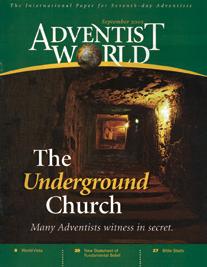
radiating to all corners of the globe?
In 2004 then General Conference (GC) president Jan Paulsen approached Bill Johnsson, Adventist Review editor at the time, with an exciting yet daunting proposal. “‘We need a magazine, a common vehicle, to help keep Adventists united throughout the world church,’ Paulsen said. The specific assignment? To send the church paper to approximately 1 million homes worldwide at no cost to the members, and to focus first on those world regions in which English is used. If funds later became available, the publication could be translated into additional languages.”5
This wasn’t an impulsive idea. It was something Paulsen had been considering from his arrival at the GC as a vice president in 1995. He was deeply concerned about keeping the church together and unified. “‘This was to be a paper that would nurture, inform, stimulate, and affirm our shared values,’ Paulsen explains. ‘It was to tell our members that we are together as one family around the world.’”
Johnsson took the proposal to the Adventist Review staff. At the time, the Review was printed weekly. Naturally some of the team was concerned. How would they be able to produce additional magazine content, especially for an international audience? Roy Adams, then a Review associate editor, said, “I’ve always felt that if ours is a global enterprise, then our principal leaders ought to have . . . ongoing direct communication with the entire Adventist community worldwide. That conviction led me to put my shoulders to the wheel, joining the rest of the staff in pulling off the difficult assignment.”
As an international magazine, “printing possibilities needed to be explored, not only in North America but in other world regions as well.”6 The answer for funding and publishing came in a miraculous form through the church in South Korea.7 “‘It was amazing how this task, which was almost unimaginable, all came together so quickly and worked—including the funding,’ Paulsen says. ‘I believe it was a
product inspired by heaven.’”8 That inspired product became what you now read: Adventist World.
“The concept of Adventist World was voted at the church’s 2004 autumn business meeting, and a presentation of its design was made July 2 at the following fifty-eighth GC Session in St. Louis. The first issue was launched in September 2005; and according to the minutes of the Adventist World publishing board of October 3, 2005, the first printing comprised 1.1 million copies. The minutes also noted five editions: Korea, South Pacific, North America, Inter-America, and Trans-Europe.”9
Like “streams of light” Adventist World magazine has been mailed to 1.6 million homes worldwide and both Adventist World and Adventist Review articles and other media have been accessed by thousands more through online platforms, websites and Adventist Review TV, a video streaming service.
And, staying true to the original intention of James White, the Adventist Review will continue to “cheer and refresh the true believer, by showing the fulfillment of prophecy in the past wonderful work of God, in calling out, and separating from the world and nominal church, a people who are looking for the second advent of our dear Saviour.”
1 “Historical Prologue,” in Ellen G. White, Early Writings (Washington, D.C.: Review and Herald Pub. Assn., 1882, 1945), p. xxiv.
2 Ellen G. White, Life Sketches (Mountain View, Calif.: Pacific Press Pub. Assn., 1915), p. 136, Retrieved from https://egwwritings. org/book/b666.
3 Ibid., pp. 137-139.
4 Ibid., pp. 140.
5 Retrieved from https://www.adventistworld.org/may-2023/.
6 Ibid.
7 Read more about it in the May 2023 issue of Adventist World, archived online.
8 Ibid.
9 Ibid.
for
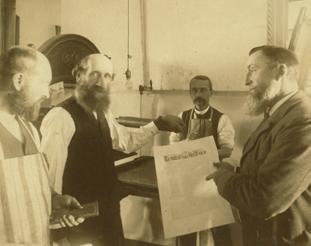

James White followed God’s counsel given through his wife, Ellen, to publish a “little paper” (read story on pp. 10-14). Commercial printers were secured to print each issue, but became an increasing concern, as there was no control when the paper would be printed, which could include Sabbath hours. In 1852 the decision was made to purchase a printing press as soon as possible.
A press was purchased, and the center of Adventist work moved to Rochester, New York, United States. There a house was secured, and the press was set up in one of the rooms. Each member of the fledgling movement did their part to print, trim, and mail the Review to believers.
Fast-forward 100 years to the Review and Herald Publishing Association, then flourishing near Washington, D.C., United States. If the pioneers could have seen the Review flying off the presses, they would have been astounded. If in another 70-plus years they would have been told that the Review had a sister publication, Adventist World, that would be printed even faster at publishing houses around the world and sent to every corner of the globe, they would have marveled at how the Lord has worked among His people.
The advance of technology has greatly enhanced the Seventh-day Adventist Church’s ability to spread the good news in multiple languages through not only print but other methods. The Internet, websites, and rapid delivery of news and information are things
Review editor Uriah
stands in front of the first printing press with the same men who when young worked on printing the Review
Above: Technology allows Pacific Press Publishing House in Boise, Idaho, United States, to rapidly print Adventist World for some parts of the world.
the church continues to explore. The Adventist Review office is no exception. We have continued to study trends and explore the best stewardship of the church’s finances, leading to a decision to change how the Adventist Review will supply the need for a print publication around the world.
Adventist World has been our instrument of choice for almost 20 years. In October of this year we will unveil a new publication that combines the best of Adventist Review and Adventist World, but under the Adventist Review name and brand. This magazine will be free to Adventist members, translated in multiple languages, and printed worldwide. But most important, the content will continue to adhere to the mission of uniting the church in preparation for Jesus’ soon coming.
BY SETH ROBERTS

Some people think the Adventist publishing work is a perfect example of our church’s unwillingness to adapt to a changing world. In the Internet age, how can paper-based periodicals, door-to-door canvassing, and handing out tracts be a wise use of the evangelistic dollar? While some believe our existing publishing apparatus can be out of step with the ministry needs of the church, publishing is just as essential to the accomplishment of our church’s mission today as when it was first established back in 1849.
Publishing was crucial to early Adventist evangelism in two ways: First, it gave people they had witnessed to (whether through public meetings or personal conversations) the chance to examine for themselves the message shared with them—on their own schedule. Second, it gave the church the ability to befriend and disciple those seeking truth across the globe when an in-person witness was not available. The world has changed drastically since the 1860s, but those two central purposes of publishing are still deeply relevant to our church’s mission in the twenty-first century.
As the world has changed, however, some ways we use printed (and now, digital) material in our evangelism have not. As a result, some believe that Adventist literature has become increasingly irrelevant to our church’s evangelistic efforts. To understand where we went wrong and how to fix it, we must examine how the early Adventist Church used literature to advance its mission.
During their first decade of existence Adventists relied almost exclusively on the efforts of in-person preachers to spread their endtime message. In this work tracts and
pamphlets became an essential tool. Why? As James White explained in 1872, the system of Adventist truth was too complex to fully understand in a public meeting. The living preacher could “cause conviction,” but for our message to be accepted, it must be “read, studied, and clearly seen.” Without this help, evangelistic preaching would accomplish “but little.” While many believers took it upon themselves to distribute tracts “indiscriminately,” White grew to frown on this practice as a waste of precious church funds, encouraging members to instead distribute tracts at our public meetings “when the crowd is impressed with an important subject.”1 Preaching and publishing worked best as a team.
A decade later Adventists discovered a second way for publishing to assist the preacher: door-to-door canvassing.2 This new method of distributing our publications had two key benefits: (a) people hesitant to come to public meetings could learn about our message through tracts and books, then be encouraged by the canvasser to connect with the church, and (b) in contrast to full-time preachers, the canvasser could support themselves. These two benefits made canvassing essential to the church’s foreign expansion in the 1880s and 1890s. Among many other places, canvassers played a central role in launching our church’s work in Samoa and Hawaii,3 Great Britain, Fiji, Jamaica, Chile, and India.4 Clearly the Adventist Church had no appetite for disconnecting publishing from personal and public evangelism. On the contrary, publishing was crucial to the canvassers’ success because they used it to enhance the only method of evangelism guaranteed to give true success—selflessly spending time with people, empathizing with their struggles, helping them with their needs, winning their confidence, and
then calling them to follow Jesus.5
In its early days the Adventist Church was heavily dependent on a comparatively small number of preachers to spread its message. There were vast territories across the globe where the church simply didn’t have the resources to send missionaries. Their periodicals and tracts became a means of befriending and discipling seekers across the globe through the postal system.
The first arm of this “silent preacher” ministry, the periodical, functioned much like a modern email newsletter. When someone subscribed to the Review (either at their own request or at the request of an Adventist friend who could assure they “would candidly read it”),6 they were joining the 1800s version of a “drip campaign.” Each new issue would explain a different aspect of the Adventist message, offer additional tracts for purchase, announce upcoming events, and encourage the reader to write back for more information.7
While members were strongly encouraged to sell periodical subscriptions, Ellen White urged writers to prepare articles “as attractive as possible,” with an “influence to persuade.”8 Following White’s lead, editors worked hard to curate content that would spread by “word of mouth.” In Britain, Stephen Haskell added illustrations to The Present Truth to match his readers’ evolving tastes.9 In South Africa the church launched two periodicals addressing local religious liberty issues.10 Similarly, the 1922 Signs of the Times addressed racial intolerance in response to a revived Klu Klux Klan.11
By today’s standards the Review and the dozens of periodicals that followed it were incredibly successful. By 1884 the eight
North American periodicals had an “aggregate monthly circulation of 200,000,”12 an astonishing 11 times larger than the North American membership at the time (17,711).13 Overseas, the contrast was often greater: In 1887, the British Present Truth had a domestic circulation almost 30 times its membership,14 while in 1895, the South African Sentinel had a domestic circulation 21 times its membership.15
The second arm of the “silent preacher” ministry, the “Tract and Missionary Society,” enabled the church to proactively befriend and disciple people they couldn’t reach through other forms of evangelism (because of distance or prejudice). Here’s how it worked: Members would mail periodicals and tracts (at their own expense) to non-Adventists, accompanied by a personal letter16 that attempted to “[draw] out the [recipient’s] true feelings”17 toward the literature, and ask if they were interested in learning more about the Adventist faith. In many cases this would lead to a back-and-forth of letters and tracts that resulted in conversion.
Started by a small group of New England women in 1870, the ministry, spurred on by Stephen Haskell and James White, quickly grew into an evangelistic behemoth. By the early 1880s, tract societies across the world were distributing close to “5 million pages of material a year” through this correspondence method, “resulting in as many converts as produced by the traditional evangelistic preaching series.”18 Even when they couldn’t interact with seekers in person, the Adventist Church implemented Christ’s method of reaching people, in principle, by befriending and discipling through the communication channel of the postal service— combining deeply relevant material with ongoing invitations to connect directly with the church.
Christ’s method is still the only one that “will give true success in reaching the people.”19 Likewise, publishing’s role of enhancing the work of the in-person witness and discipling seekers we cannot reach in person is just as relevant today as it was in 1849. In the intervening century and a half the world has changed drastically in three ways that compel us to adjust our means to better accomplish the same ends:
Age of Information: Technology has enabled an explosion in advertising and access to information, leading consumers to increasingly ignore both. For example, the average consumer receives more than 3,000 marketing messages a day,20 while more than 500,000 new books are published each year in the United States alone.21
Age of Entertainment: The arrival of new communication mediums—radio, television, the Internet, and social media—has shifted communication to dominantly visual mediums. Context and clarity of thought, valued in a print-based culture, have been replaced by entertainment value as the primary quality22—a trend most clearly demonstrated in the rise of addictive apps such as TikTok and Instagram.
Age of Authenticity: Western culture has shifted from a Christian paradigm (in which Christianity is the default belief system) to a secular paradigm (in which Christianity is one of many acceptable belief systems). This shift reflects a rejection of the hypocrisy and scandal perennially associated with organized religion while retaining the desire to experience an authentic sense of meaning and higher purpose.23
In this age of entertainment overload, Christ’s method of reaching people will find success when
nothing else will. People jaded by organized religion, searching for a genuine spiritual experience, will be convinced only when they see God’s “power [at work] in our . . . hearts and lives.”24 In this new age, publishing’s two roles are equally necessary if their methods can be adapted to the realities of the twenty-first century:
Enhancing the Living Witness: At a time during which people are more skeptical than ever, written material addressing a seeker’s deepest and most difficult questions can demonstrate care and explain the logical rationale behind a genuine personal witness.
Discipling From a Distance: For those we can’t reach directly, the Internet provides an unprecedented opportunity to spread relevant digital content (podcasts, videos, reels, blog posts, and so on) while encouraging viewers/ readers to “opt in” to email-based newsletters (the periodicals of the twenty-first century) and connect directly with Adventists who can guide them on their journey toward truth—in much the same way as periodicals and the tract societies did in the 1800s.
Publishing continues to prosper in many divisions across the world,25 yet some adjustments are called for in our changing world to avoid this tool becoming irrelevant to our evangelistic efforts. The distribution of tracts and door-todoor canvassing do produce some evangelistic success, but the efforts fail to realize their full potential when they are not integrated with the larger evangelistic cycle.
Tracts: The use of literature has been largely siloed from the rest of our evangelistic work, preventing a deep integration with other ministries. When literature distribution
is emphasized, it is often seen as a “sowing” activity in which tracts are handed out indiscriminately, with little connection to the church other than the name of the church on the tract or an accompanying flyer. Further, some think using literature in combination with other events is merely a duplication of effort (i.e., “Why should we give them a tract when they just listened to a presentation on the same topic?”). As a result of these views, churches seeking to emphasize Christ’s method of relational witnessing see literature as an irrelevant product of a bygone era of “hit-and-run” evangelism.
Canvassing: Canvassing has become increasingly disconnected from the local church and its evangelistic work. As the higher-priced Bedtime Stories and The Bible Story became the primary source of income for literature evangelists in the 1950s, the work of canvassing shifted from a mission-centered partnership with the local church to a commercial enterprise that ultimately fell victim to unsustainable debt. Student magabook programs, introduced in the United States in the mid-1990s, represent a muchneeded shift back to a ministry-focused model, yet still with significant gaps: While programs collect Bible study interests for their host church during the summer, poor coordination often results in little to no follow-up by the church.
Periodicals: Our periodicals have struggled to adapt to the digital age. In response, church leaders have invested significant resources in our periodicals and publishing houses, acknowledging that “if we won’t invest in the digital world, we will be left in the same spot as Kodak.”26 Much remains to be done, however, and our papers have yet to regain the non-Adventist readership that once made our periodicals a potent evangelistic tool.
When you strike up a casual conversation with a stranger, share a relevant tract and offer to continue the conversation.
If our books, tracts, and (now) digital content are to regain their place as an essential component of our work, we must be willing to radically alter how we use them to meet the needs of a twenty-firstcentury secular age, following the principles that led us to success in the first place. While the responsibility for developing relevant publications, adopting a “digital-first” periodical strategy and rebuilding our canvassing operations rests with our publishing institutions and conference/union leadership, the most important steps toward a more effective partnership of preacher and paper must be taken by our local churches.
Integrate Literature Into Evangelism: We must integrate literature into the ministry of every local church ministry that interacts with their community. Books and tracts relevant to every church event should be sold (as appropriate) or given away, be it a health class, cooking school, Vacation Bible School, prophecy seminar, stop-smoking seminar, or community service center. A church’s evangelism strategy should include literature being “planted” at every opportunity, enabling each recipient to understand our message
within the context of a relationship with their local church.
Curate World-Relevant Material: The books and tracts we share with our communities must be deeply relevant to them. 27 We must take care in selecting materials that match our individual demographics and felt needs. Using GLOW as an example, use “An Intelligent Faith?” in a secular, educated neighborhood, “Certainty in an Uncertain World” in a politically unstable region, “When Freedom Dies” in a Bible belt neighborhood, and “Can Dead People Talk?” in an animist community.
Plant Seeds With a Personal Touch: For churches without an active schedule of outreach events, literature can help develop relationships with the community—just as the Missionary and Tract Societies did in the late 1800s. For example, members can assemble simple care packets with everyday items (snacks, lotion, etc.), some relevant tracts, and a handwritten note with an invitation to connect further. When you strike up a casual conversation with a stranger, share a relevant tract and offer to continue the conversation. In Japan, for example, this simple approach led to a local fisherman accepting Bible studies and baptism.28
Publishing was central to the work of the early Adventist Church. It enhanced the work of the in-person witness and discipled seekers we couldn’t reach in person. In the same way that the publishing work helped build the early Adventist Church, it can help advance the mission of the church at the closing of its work. Today published works, both print and digital, can give people the opportunity to examine for themselves the message we share with them, at their own convenience, on their own schedule. If we are intentional, we may also use
published works to befriend and disciple those in our immediate communities or across the globe and share spiritually relevant truths for this day.
1 James White, An Appeal to the Working Men and Women in the Ranks of Seventh-day Adventists (Battle Creek, Mich.: Steam Press of the Seventh-day Adventist Publishing association, 1872), pp. 2-10.
2 German Martinez, “King, George Albert (1847–1906),” Encyclopedia of Seventh-day Adventists, Oct. 27, 2022, https://encyclopedia. adventist.org/article?id=GJK9 (accessed May 9, 2024).
3 J. N. Loughborough, The Great Second Advent Movement (Nashville: Southern Pub. Assn., 1909), pp. 352, 361.
4 Gerald Wheeler, S. N. Haskell: Adventist Pioneer, Evangelist, Missionary, and Author (Nampa, Idaho: Pacific Press Pub. Assn., 2017), pp. 106, 354, 355, 357, 360.
5 Ellen G. White, The Ministry of Healing (Mountain View, Calif.: Pacific Press Pub. Assn., 1905), p. 143.
6 Publishing Committee, “How Shall We Circulate Publications?” Second Advent Review and Sabbath Herald 1, no. 1 (November 1850): 7.
7 For example, see Second Advent Review and Sabbath Herald 1, no. 4 (January 1851).
8 Ellen G. White, “Address and Appeal, Setting Forth the Importance of Missionary Work,” Review and Herald, Dec. 19, 1878, p. 1.
9 Wheeler, p. 126.
10 Loughborough, p. 351.
11 Wheeler, p. 336.
12 J. N. Andrews, “Seventh-day Adventists,” The Present Truth 1 (May 1884): 2.
13 “Seventh-day Adventist Statistics, 1884,”https://documents. adventistarchives.org/Statistics/ASR/ASR1884.pdf (accessed May 9, 2024).
14 The Present Truth had a domestic circulation of 3,400 (cf. Wheeler, p. 126) compared to the British mission’s 1887 membership of 115 (https://documents.adventistarchives.org/Statistics/ASR/ASR1887. pdf#search=1887).
15 The English journal had a circulation of 4,000, compared to the 1895 South African conference membership of 184 (see Loughborough, p. 351).
16 Loughborough, p. 363 (cf. Wheeler, pp. 84, 178).
17 E. G. White, “Address and Appeal, Setting Forth the Importance of Missionary Work.”
18 Wheeler p. 88.
19 E. G. White, The Ministry of Healing, p. 143.
20 Seth Godin, Permission Marketing (New York: Simon & Schuster, 1999), p. 29.
21 Dean Talbot, “Number of Books Published Per Year,” Wordsrated, Feb. 2, 2022, https://wordsrated.com/number-of-bookspublished-per-year-2021/(accessed May 9, 2024).
22 Neil Postman, Amusing Ourselves to Death: Public Discourse in the Age of Show Business (New York: Penguin, 2005), p. 87.
23 Charles Taylor, A Secular Age (Cambridge, Mass.: Harvard University Press, 2007), p. 506.
24 E. G. White, The Ministry of Healing, p. 469.
25 William G. Johnsson, “Publish or Cherish,” Adventist Review, June 9, 1983, p. 14.
26 Robert Lemon (quoted in Andrew McChesney, “With Goal of Repositioning Its Media, Adventist Church Overhauls North American Publishing Operations,” Adventist Review, June 18, 2014, https://adventistreview.org/adventist-church-overhauls-u-s-publishing-operations/adventist-church-overhauls-north-american-publishing-operations/).
27 Relevance does not imply a lack of faithfulness to doctrinal truth. To apply Alec Moyter’s reflection on preaching to written material, every author has two responsibilities: “First to the truth, and secondly to this particular group of people. How will they best hear the truth? How are we to shape and phrase it so that it comes home to them in a way that is palatable, that gains the most receptive hearing, and . avoids needless hurt?” (quoted in Tim Keller, Preaching: Communicating Faith in an Age of Skepticism (New York: Viking Press, 2015), p. 21.
28 Kurihara Kimiyoshi, “Japanese Fisherman Caught by Jesus,” Adventist Mission, n.d., https://www.adventistmission.org/ japanese-fisherman-caught-by-jesus (accessed May 14, 2024).
Seth Roberts is originally from Sydney, Australia, and now serves as assistant director for the Literature Ministries Department in the Michigan Conference of Seventh-day Adventists.

It was just one week before her twenty-first birthday that Ellen White was given her well-known “streams of light” vision, setting the stage for the vast publishing outreach for what would later become the Seventh-day Adventist Church.
While the vision from which Ellen White gives the message to her husband, James, that he is to “print a little paper” that will eventually become “like streams of light” encircling the world is well known, what is perhaps less well known is the setting of that historic vision.
On November 19, 1848, just four years after the Great Disappointment, a group of Advent believers gathered in Dorchester, Massachusetts, to discuss insights gained from Bible study, focusing especially on the seventh-day Sabbath, the seal of God, and the sealing of the 144,000 as outlined in the book of Revelation.
This topic had been studied in depth by Joseph Bates, who, through Bible study, connected the Sabbath with the sealing described in Revelation 7. This understanding was encouraged and, to some extent, clarified by the vision given to Ellen White during the meeting in Dorchester, in which she identified the Sabbath truth with the seal of God that, like the sun rising in strength, grows brighter and brighter.1
Significantly, it was after coming out of this vision that she told her husband he must print a paper for the Advent believers that would “be like streams of light that went clear round the world.”2 In other words, through the printed word, the sealing message of the seventh-day Sabbath would spread worldwide, paving the way for the final events, and preparing people to receive the seal of God.
Some months after the Dorchester vision, Ellen White had another vision, in which she was told “he [James White] must write, write, write, and walk out by faith.”3 Fortunately, James took this message to heart, and, as Ellen White later wrote, “he immediately began to write, and when he came to some difficult passage, we would unite in prayer to God for an understanding of the true meaning of His word.”4
It was “the true meaning of His word” that burned within their hearts, compelling the early Adventists to publish The Present Truth, a little paper that started small but was the beginning of those prophetic “streams of light.” As we know, that little paper continued growing and became the Advent Review and Sabbath Herald, and later the Adventist Review. This magazine that had such humble beginnings is now one of the oldest magazines in the United States.5
James White was clear regarding the purpose of Adventist publications. Writing in The Advent Review, a 48-page pamphlet issued between numbers 10 and 11 of The Present Truth, he stated:
“Our design in this review is to cheer and refresh the true believer, by showing the fulfillment of prophecy in the past wonderful work of God, in calling out, and separating from the world and nominal church, a people who are looking for the second advent of our dear Saviour.”6
So eager were the early Adventists to spread the message of truth that they eagerly spent their time, money, and energy disseminating publications far and wide. Starting with The Present Truth in July 1849, the Seventh-day Adventist publishing work quickly grew to include many more printed materials.
Noting the power of publications, J. N. Andrews, early Adventism’s foremost scholar, stated in his book History of the Sabbath and First Day of the Week, published in 1873, that “numerous publications on Prophecy, the Signs of the Times, the Coming of Christ, the Sabbath, the Law of God, the Sanctuary . . . have been issued within the past twenty years, and have had an extensive circulation, amounting, in the aggregate, to many millions of pages.”7 This is remarkable, considering that by 1873 Seventh-day Adventist Church membership stood at just 5,875.8
These themes—prophecy, signs of the times, the coming of Christ, the Sabbath, the law of God, the sanctuary—have been cornerstones of the Seventh-day Adventist message since that time, and millions of people have learned these truths through Adventist
So eager were the early Adventists to spread the message of truth that they eagerly spent their time, money, and energy disseminating publications far and wide.
publications, including the Adventist Review, and since 2005 its sister publication, Adventist World, which is printed monthly in seven different languages and distributed in more than 140 countries. It is available digitally in 12 languages.
The story is told by Ellen White of how, following the publication of the very first issue of The Present Truth, “the precious printed sheets were brought into the house and laid upon the floor, and then a little group of interested ones were gathered in, and we knelt around the papers, and with humble hearts and many tears besought the Lord to let His blessing rest upon these printed messengers of truth.”9
God told Ellen White that the fourth angel of Revelation 18:1-4 represented, to a great extent, the publishing houses and the publishing work that would go on until Christ’s coming! What a privilege it has been for each of us to use printed and electronic religious materials, including the Adventist Review and the Adventist World magazines, to point people to Christ and His soon return!10
Today let us continue to pray for these “messengers of truth” as they go, like streams of light, around the world, praying they will continue to provide biblical understanding and hope as they shine brightly for Him.
1 Ellen G. White, The Publishing Ministry (Hagerstown, Md.: Review and Herald Pub. Assn., 1983), p. 15.
2 Ellen G. White, Life Sketches of Ellen G. White (Mountain View, Calif.: Pacific Press Pub. Assn., 1915), p. 125.
3 Ibid., p. 126.
4 Ibid
5 William G. Johnsson, “Our Roots and Mission,” Adventist Review, Oct. 14, 2023, https://adventistreview. org/about/our-roots-and-mission/ (accessed May 2, 2024).
6 E. G. White, Life Sketches, p. 136.
7 J. N. Andrews, History of the Sabbath and First Day of the Week, 2nd ed. (Battle Creek, Mich.: Steam Press of the Seventh-day Adventist Publishing Association, 1873), p. 505.
8 See “Church Membership Statistics,” https://www.adventistarchives.org/church-membership (accessed May 12, 2024).
9 E. G. White, Life Sketches, p. 126.
10 Ellen G. White, Testimonies for the Church (Mountain View, Calif.: Pacific Press Pub. Assn., 1948), vol. 7, p. 140.
Ted N.C. Wilson is president of the General Conference of Seventh-day Adventists. Additional articles and commentaries are available on X (formerly Twitter): @pastortedwilson and on Facebook: @Pastor Ted Wilson.

Discovering the Spirit of Prophecy
Webster defines philanthropy as “goodwill to fellow members of the human race”; “an act or gift done or made for humanitarian purposes”; and “an organization distributing or supported by funds set aside for humanitarian purposes.”1 Simply stated, philanthropy is love for humanity. But how does philanthropy relate to the Seventh-day Adventist faith and mission?
PHILANTHROPY AND ADVENTIST MISSION
There are many ways in which a believer can express their love for humanity. Some give their time. Those are the many church volunteers who assist in the Sabbath School divisions, help with the Pathfinder club, serve as elders, deacons, or greeters, etc. Others support the ministry of the church by making financial contributions. All these activities are a part of the mission of the church. In fact, philanthropy has been a part of the Christian mission since the time of the apostles.
The book of Acts reminds us how early Christians gave generously to support those in need. “All the believers were one in heart and mind. No one claimed that any of their possessions was their own, but they shared everything they had. With great power the apostles continued to testify to the resurrection of the Lord Jesus. And God’s grace was so powerfully at work in them all that there were no needy persons among them” (Acts 4:32-34, NIV). Giving became a signature of their identity.
In the United States the practice of giving dates to the early colonial period by the founding of Harvard College and other similar religious institutions. This practice was
in the form of voluntary and charitable giving. The early Sabbathkeeping Adventists also gave regularly to those in need. Ellen White saw giving as an act of following the example of Jesus. “We realized that Christ took a personal interest in men and women while He lived on this earth,” she penned. “We are to go about doing good, even as He did.” Moreover, it was such acts of kindness that removed “suspicions” and “prejudice” against believers, and as a result many “accepted the truth.”2
Ellen White herself regularly gave clothes to the needy, helped neighbors, bought food and other items for the destitute. She took in her home students or colporteurs, sometimes for months, until their financial situation improved. On one occasion in 1889, Ellen White challenged a brother to match her gift of US$100 to Nellie L., a needy widow and her three children, as she lived in poverty and needed assistance.3
Putting faith and philanthropy in collaboration could lead to fruitful results. But while religious giving during the past 25 years has made up the bulk of charitable giving in the United States—27 percent overall—for Seventh-day Adventists giving is much more than charity.4 It is not an end in itself. Giving is related to the very mission that God gave His followers to proclaim the “everlasting gospel” to a world that desperately needs Jesus and His saving grace. In fact, the Seventh-day Adventist Church was founded by dedicated individuals who gave of their time, energy, talents, and financial means to make this movement what it is today. And the work is not done.
One way we can be inspired and follow in the footsteps of our early pioneers and their enthusiasm and passion for Jesus is to go back and remind ourselves of their stories. One particular organization that not many Adventists are aware of is Adventist Heritage Ministries, which works closely with the Ellen G. White Estate, Inc. It owns and operates four historic sites that have played a significant part in the development of the Seventh-day Adventist Church and our distinctive beliefs.
The Historic Adventist Village in Battle Creek, Michigan, hosts a number of significant buildings related to the beginning of the Seventh-day Adventist movement, including the Dr. J. H. Kellogg Discovery Center and the home of James and Ellen White, the oldest known Seventh-day Adventist landmark in Battle Creek. You can visit the sites throughout the year and learn about the formal organization and early work of Seventh-day Adventists.
The William Miller farm is another landmark, located between Whitehall, New York, and Fairhaven, Vermont. The site includes the Miller house, several farm buildings, and the purported ascension rock. The William Miller chapel is also available for tours. The graves of William and his wife, Lucy, are nearby. Learning about the “Father” of Adventism is an exciting and inspiring opportunity.
Hiram Edson’s home is located in western New York State, between Clifton Springs and Port Gibson. The site has restored Hiram’s barn, where early pioneers met and discussed their beliefs. One can easily say that this is the birthplace of Seventh-day Adventist theology. Hiram is also remembered for redefining the sanctuary doctrine after the Great Disappointment in 1844.
Joseph Bates’ boyhood home was acquired by Adventist Heritage Ministries in 2005. The house was built in 1742 and is the oldest existing home in Fairhaven, Massachusetts. Joseph was a sea captain who accepted the Millerite message and became an Advent preacher. After the Great Disappointment he accepted the seventh-day Sabbath and introduced it to the dis-

Philanthropy has been a part of Christian mission since the time of the apostles.
appointed believers, including James and Ellen White. Here one can learn the story of his life and work and be introduced to the Sabbath message. The house outside has been completely restored, and work is ongoing at present to create a first-class interactive museum inside. Between 10,000 and 15,000 people visit these sites each year. In a literal way, they are a powerful tool for sharing the Adventist story, inspiring young and old to have the same commitment to Jesus as the early believers. Through these sites visitors are introduced to Adventism’s founders and their faith journey. Moreover, the sites introduce Jesus and the unique beliefs of Seventh-day Adventists to those who are not acquainted with the church and its theology. I hope each of us will learn about the work of Adventist Heritage Ministries and become a partner in this vital ministry as we approach the end of time.5
1 “Philanthropy,” Merriam-Webster Dictionary, https://www.merriam-webster.com/dictionary/philanthropy.
2 Ellen G. White, Welfare Ministry (Washington, D.C.: Review and Herald Pub. Assn., 1952), pp. 328, 327.
3 Ibid., p. 326.
4 See Anna Pruitt, “Giving to Religion in Giving USA 2023,” Lake Institute on Faith & Giving, Jan. 9, 2024, retrieved from https://lakeinstitute.org/resource-library/insights/july-issue1-2023/.
5 For more information about Adventist Heritage Ministries, visit www.adventistheritage.org.
Hebe Soares is the development director for the Ellen G. White Estate and Adventist Heritage Ministries at the General Conference of Seventh-day Adventists in Silver Spring, Maryland. For more information on Adventist Heritage Ministries, please visit adventistheritage.org.



Our world has never been glitzier, more tempting, or more confusing for our children than it is right now. Every day different messages bombard us about what we should want and fill our minds with, how we should spend our time, and where our worth is—yet very little of this is grounded in the One who created us; the One who has a plan and a future for our children. As a parent of teenagers, I see the battle rage over the minds and hearts of my children. Perhaps you do too.
As a mother, my daily prayer is for my children to have their own walk with God—for faith to be alive and real to them. If you’re a parent or grandparent, I’m sure you’ve also prayed for this. Like me, perhaps you’ve wondered: God is working, but is there more I can do to raise children who know and love Him?
Over the years I’ve seen God answer my prayer as my children grow in Him. I see them choose to spend time with God because they
really want to. I’ve observed how time with Him steadies them as nothing else can. I see them grow in knowledge and conviction as they think deeply about their faith. It makes my heart glad to see they have a burden to share God and our unique Seventh-day Adventist message with others. But although my husband and I have always tried to make family worship a meaningful, vibrant part of our days, it hasn’t always been easy to find age-appropriate, accessible resources that purposefully build a love for Jesus and His living Word.
As our world heaves and groans, I believe it’s time to be even more purposeful with the next generation—to build a love for Jesus and a strong knowledge of the timeless truths in His Word. Perhaps you’ve seen the data and know there’s a shallow understanding in our young people about some of our most basic doctrines. For our children to live well at this time in earth’s history, they need more.
I believe now is the time for us to focus on this. It’s time to model what a life-changing friendship with Jesus is like and show our children how to spend meaningful time with God in His Word and in prayer.
It’s time to add more depth and rigor to what we’re teaching our children and youth so they can be convicted about what they believe while intentionally shaping a biblically informed worldview, including the 28 Fundamental Beliefs.
It’s time to equip busy, tired parents with age-appropriate Bible lessons that bring families together every day to share these messages in winsome, personally challenging, and missional ways.
It’s time to equip Sabbath School teachers with the best methods and many new resources, along with ideas about how to cultivate healthy culture in their classrooms.
Yes, it’s time. And the General Conference Sabbath School and Personal Ministries Department invites you to pray as we develop
the new Alive in Jesus Sabbath School curriculum for children and youth, set to launch in January 2025 around the world.1 As it’s rolled out, this new curriculum will replace GraceLink, Junior PowerPoints, Real-Time Faith, and Cornerstone Connections.
Our babies have always been grouped together with the Beginner class, yet developmentally there’s a big difference between a 5-month-old and a 3-year-old child. In response to this, Alive in Jesus includes brand-new Babies resources (birth through 12 months), to help parents to be intentional with the spiritual growth of their little one from the time they’re born. The parent book offers spiritual encouragement and advice for milestones, along with four simple programs that revolve primarily around song. The teacher guide includes these same four programs, which are also shared together in Sabbath School. After this Babies Sabbath School time is a time especially for parents, with weekly parenting small group handouts that nurture the faith of parents. These beautifully designed parent handouts are tailored for both church-attending and community parents. Indeed, the Babies resources focus first on the parent’s spiritual growth to help them impart a clear picture of God to their new baby. A strong focus on the parent’s spiritual growth, in addition to the child’s, continues through all lower levels in the new curriculum.
Other new features of the Alive in Jesus student guides are numerous, including that Beginner now has a weekly Bible story—to be read each day instead of a story each month. From Kindergarten, all lessons have daily readings, and the same stories are shared in Kindergarten and
Primary to make it easier for parents who have children in both groups, or small churches who want to combine these classes. Every day an appealing narrative is shared, as children are prompted to open their Bibles, followed by rich discussion questions for families to share together, along with prayer prompts and activities that encourage application of the Bible message. Each week children can look forward to a special Sabbath feature, such as a nature lesson, Adventist history story, a family activity, or a mission story. An audio recording of the lessons can be played on the Alive in Jesus app, and families can listen to a quarterly playlist of Scripture songs to help children remember their memory verses. New artwork on every page brings the Bible stories and messages to life in the minds of the children in fresh ways, as children from around the world see themselves in the diversity of pictures.
Ultimately, we want to make it easy for parents to bring their children to the feet of Jesus every day through a variety of appealing approaches.
If you’re a Sabbath School teacher, you can expect an easy-to-follow program that first speaks to your spiritual growth before you prepare to teach. You’ll find both a simple program and a detailed program, along with storytelling strategies, crafts, new and familiar music (available for download on our website and app), and the philosophy of the new lessons embedded in every program. From Kindergarten you’ll find nature lessons, mission stories that are aligned with the weekly Big Ideas, collector cards, and strategies to share and also deepen the Bible story that has been explored during the week.
2025 Babies (birth through 12 months)
Beginner (1-3 years)
2026 Kindergarten (4-6 years)
Primary (7-9 years)
2027 Junior (10-12 years) Teen (13-14 years)
2028 Youth (15-18 years)
To help you prepare for this new curriculum, you can find training videos on our Alive in Jesus website.2
Alive in Jesus is distinctly Seventh-day Adventist and shows that the Bible is the source of truth and peace in an ever-changing world. Its wholistic approach on grace, character, and mission build a love for Jesus and His message. But this Alive in Jesus is also for you, parents, grandparents, caregivers, and leaders, as we believe it will strengthen your walk with God. Please pray for God to lead the development of this new curriculum and pray for the children in your churches and spheres of influence. Truly, may our children “take root downward, and bear fruit upward” (Isa. 37:31).
1 Please speak to your division Children’s Ministries director for launch information in your division.
2 Visit www.aliveinjesus.info for a more detailed curriculum overview, sample lessons, training videos, and more information about the new Sabbath School curriculum.
Nina Atcheson lives in Melbourne, Australia, and serves as a curriculum manager and senior editor for the General Conference of Seventh-day Adventists Sabbath School and Personal Ministries Department.
QDoes the emphasis on revival in the church imply that the church is spiritually dead?
ANo, the church is not dead. The church experienced the coming of the Spirit during Pentecost, and since then the Spirit has remained with the church and will continue to be with it until the very end. A strong and vibrant spiritual life should be a constant goal for all believers and needs to be constantly nurtured. I will suggest that, in a very precise way, spiritual revival (from Latin revivere, “to live again”) is initiated at conversion, is threatened during our Christian life, and needs to be constantly strengthened.
SPIRITUAL DEATH AS A HUMAN CONDITION
The condition of humanity after the Fall is described in the Bible as a state of emotional, spiritual, social, and moral death, leading to eternal physical death (Rom. 1:21, 22; 5:12; 6:23). We are by nature dead in our trespasses and sins under the enslaving lordship of sin (Eph. 2:1, 2). Our greatest need is spiritual revival, that is to say, the restoration of the spiritual life we lost. The psalmist knew that only God could “revive me again” (Ps. 71:20, NASB),* and Jesus came announcing the free gift of an abundance of life (John 10:10). The restoration of life is possible only and exclusively through the sacrificial death of the Son of God. Any discussion of revival in the church should begin with the realization that we are by nature spiritually dead and that we are revived by faith in the saving power of Christ. This restoration of life is described as a new birth from above (John 3:5) by which we become part of God’s new creation (2 Cor. 5:17). Once revived, believers do not walk according to the flesh but according to the Spirit (Rom. 8:4, 5), in
newness of life (Rom. 6:4). The new life is modeled and shaped according to the life of Christ (Matt. 11:28-30).
The believer is not exempted from temptations and from the pressure of the sinful attraction of a spiritually dead world. Aware of this constant threat, we are admonished to live the new life in a state of watchfulness or alertness (Matt. 24:42; 1 Cor. 10:12; 1 Peter 5:8). The vital connection with the risen Lord established at conversion should be constantly maintained and nurtured (Col. 1:21-23). Otherwise the new life begins to lose its vitality and to languish as the virus of sin gains ascendancy in our life and we become spiritually ailing Christians. In practical terms this means that our connection with Christ is damaged by the absence of daily communion with Him through prayer, meditation, and the study of His Word, and by the absence of fellowship with other believers and involvement in the mission of church. When this happens, we need spiritual revival.
One of the most important things in the Christian life is the realization of our constant need of Jesus and the Holy Spirit. Revival means that we need to refix our eyes on Christ, remembering with gratitude and meditating on the magnitude of His sacrifice (2 Peter 1:9; Heb. 12:1, 2). Then, in the power of the Holy Spirit, we need to strengthen the weak hands and feeble knees and “make straight paths for your feet, so that the limb which is impaired may not be dislocated, but rather be healed” (Heb. 12:13, NASB). Perseverance in our dependence on, fellowship with, and submission to the crucified Savior is the antidote for an ailing spiritual life (Phil. 2:12, 13; Gal. 5:22-24; Rev. 14:12).
*
Ángel Manuel Rodríguez, Th.D., is retired after a career serving as pastor, professor, and theologian.



I am experiencing more frequent and worsening bouts of anger. Can this damage my general overall health?
Anger, like any emotion, is a natural response to certain stimuli. When it becomes a dominant force in one’s life, however, it can have significantly negative effects on physical and mental health. The physiological and psychological toll of chronic anger can be profound, impacting not only the individual experiencing it but also those around them.
Prolonged anger can negatively affect cardiovascular health. When we experience anger, our bodies release such stress hormones as adrenaline and cortisol, which can elevate blood pressure and heart rate. Over time, this chronic activation of the body’s stress response system can lead to hypertension, increased risk of heart disease, and even stroke.
Anger can weaken the immune system.* The constant state of agitation associated with anger can suppress the immune response, making individuals more susceptible to infections and illnesses. Studies have shown that people who struggle with chronic anger are more likely to experience frequent colds, infections, and other health issues.
Mental health is affected by unresolved anger. Chronic anger can contribute to the development of mood disorders, such as depression and anxiety. The persistent negative thoughts and emotions associated with anger can erode one’s sense of well-being and lead to feelings of hopelessness and despair. Anger can strain relationships with friends, family, and colleagues, leading to social isolation and loneliness.
Anger can impair judgment and decision-making abilities. When consumed by anger, individuals may act impulsively and irrationally, leading to consequences they later regret. Both personal and professional relationships may be damaged, perhaps even beyond repair.
Here are four strategies to help overcome anger:
Prayerful Meditation: Meditating on the Word, God’s wonderful creation, and His ways can help individuals become more aware of their emotions and better equipped to manage them. We can learn to recognize anger without being consumed by it, allowing for a more controlled response.


Healthy Expression: Find healthy outlets for expressing anger, such as talking to a trusted friend or therapist, journaling, or doing physical activity to release pent-up energy and tension.
Stress Management: Since anger is closely linked to stress, adopting stress management techniques can be instrumental in reducing its intensity and frequency. This may include such practices as deep breathing exercises or engaging in hobbies and activities that promote relaxation and enjoyment.
Conflict Resolution Skills: Learning effective communication and conflict resolution skills can help prevent anger from escalating into destructive conflicts. By attentively listening to others’ perspectives, individuals can navigate disagreements constructively.
Anger is a natural and inevitable emotion, but its chronic and unmanaged expression can have profound negative effects on both physical and mental health. By intentional and focused approaches, and, most important, by God’s grace, individuals can overcome anger and cultivate greater well-being and resilience in their lives. Keep this text in mind: “I can do all things through Christ who strengthens me” (Phil. 4:13).
* Samuel Brod, Lorenza Rattazzi, Giuseppa Piras, and Fulvio D’Acquisto, “ ‘As Above, So Below.’ Examining the Interplay Between Emotion and the Immune System,” Immunology 143, no. 3 (Oct. 2, 2014): 311-318, https://doi. org/10.1111/imm.12341.
Peter N. Landless, a board-certified nuclear cardiologist, is director of Adventist Health Ministries at the General Conference. Zeno L. Charles-Marcel, a board-certified internist, is an associate director of Adventist Health Ministries at the General Conference.
T“May I Tell You a Story?”
BY DICK DUERKSEN
he phone is filled with shrieks and screams. The sounds of a woman’s life coming apart. High-pitched and insistent. Desperate! The sounds still jar her soul, but she listens carefully and then speaks calmly, slowly, and kindly, making notes on the name and home location for the woman whose life is exploding in pain.
Esther Birungi leads the Domestic Violence Unit for Ourganda, a small nonprofit organization in Uganda’s Rwenzori Mountains. Her job, the life she has purposefully chosen, is to save wives from the husbands who are beating them. Her middle name ought to be “Hope,” for that is what she brings to the highlands.
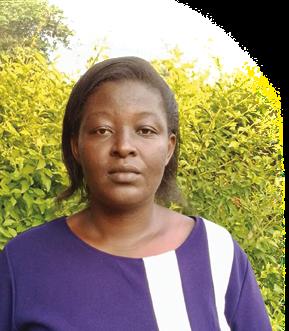
“No,” she’ll quickly correct you. “I’m not here to save the women. I’m here to save the families by helping the men become better husbands. With help, they will be safe husbands who treat their wives with honor.”
Saving families is in her blood, an illogical choice she made as she watched her father nearly beat the breath out of her mother. Esther was a desperate 17-yearold teenager then, determined to escape her father’s violence, racing with her younger sister toward an elusive hope.
Today Esther is 37, the wife of a loving husband and the mother of four children. She is also the heart of hope for hundreds of abused women in Uganda.
“I’m Babwisi,” she says with pride, denoting her people group. “That means I can listen well to most of the hill languages.
Esther Birungi
That means that I know the abuse, and that I also know the answer.”
Esther’s phone rings often. “Too often,” she says. Every ring signals a strident call for help. Each answer brings Esther the screaming voice of a wife trying to hide from her husband’s drunken rage, or to an urgent neighbor woman crying for Esther to “come quickly before he kills her.”
“These are not bad men,” she says. “They are men who need to learn that hitting your wife is never acceptable, men who need to choose kindness so they can become good husbands.”
The Rwenzori Mountains are not an easy place to live. The mountains are steep, the trails are narrow and windy, clean water must be carried from miles away, and houses are made from dirt that caves away when the clouds bring rain. No one has a bicycle. Alcohol is cheap. Happiness seldom happens. Screaming is common.
When a woman is being beaten, she has few options. None of them good. If she runs away, she will be beaten even harder when she returns. If she goes home to her mother and father, they will return her to the husband who bought her with a dowry price. And the beatings will continue. If she chooses to call the police, there may not even be a phone number for her to call. The authorities have few resources and require a 45,000-shilling fee to cover the taxi fare for them to respond to her screams. No one has that much money.
Today there is a better option. Call Esther. There is at least one small flip phone in the village, and everyone has Esther’s number.
“Call me,” she says. “I’ll come. I’ll confront your husband. If he refuses to stop beating you, I’ll pay for the police to take him away. Then I’ll pay the jail fee, so you can have peace at home.”
At first no one believed her. Until the day she arrived at Marta’s house and
confronted Jonas, the husband with a bloody fist.
“Will you stop beating your wife?”
“Who are you to stand there and talk to me about my life and my wife? She is my property, and I’ll beat her if I choose. You cannot stop me.”
“I am stopping you right now,” Esther continues calmly, “or you will be in jail tonight.”
Jonas swore loudly, not really believing, but wondering if this interfering woman might have connections with the jail. Later that evening the police arrived on a boda-boda motorcycle taxi and took him away.
The next morning Esther was at the jail, smiling kindly and asking to see Jonas.
“This is a ‘ManKind contract’ for you to sign,” Esther said as she handed Jonas the paper. “Sign it, and you are promising to be kind to your wife. You are promising not to beat her anymore, but to treat her with kindness. Sign the contract, and I will take you home.”
Jonas was the first to sign the kindness contract and join the new ManKind Club. That was nearly two years ago. Since then, the ManKind Club has grown to include more than 50 men, and domestic abuse in the mountain villages has been reduced by 50 percent.
“No one thought this could happen,” say the leaders of Ourganda, the nonprofit that employs Esther. But kindness changes everything.”
Members of the ManKind Club, 50 husbands who have signed the pledge, have helped Esther confront 630 abusive husbands. They also visit the men who’ve been taken to jail, bringing them food, blankets, water, clean clothes, and whatever else the men need. While there they share the contract, offering forgiveness, prayers, support for overcoming addiction, and another chance for the men to return home and learn to become better husbands.
“Keep choosing kindness,” they say. At home, back up on the mountain,
“Come quickly before he kills her.”
the 50 women of the Soul Sisters Club provide food, water, and emotional encouragement for battered wives.
“Keep choosing kindness,” they say. Esther, and other Ourganda leaders, offer much more than intervention. They make sure each village has access to nearby pure water. They provide first aid and health education, and have even covered the medical expenses for 60 essential surgeries.
“Empty lives often lead to alcohol and violence,” an Ourganda leader says, “so we are providing microfinance options and helping families and communities develop small businesses that give men and women a new sense of personal worth.”
Knowing that she is challenging people to make major changes, Esther also leads three-day seminars on love and responsibility for teenagers. Those were so well received that she began inviting adults to attend.
“From the start, it’s been a success,” writes journalist Bruce Benway. “Over the course of three weeks, 12,000 people showed up. The women, beaten and bruised, sitting next to the men who have beaten and bruised them. Everyone waiting to hear what Esther has to say about love and respect, kindness and courtesy, all the things she talks about in her home visits.”
“Change starts with each of us,” Esther says. “If we want to change from abuse to freedom, we all need to take a stand today!”
The houses are still mud, but happiness is happening.
Keep choosing kindness!
Dick Duerksen, a pastor and storyteller, lives in Portland, Oregon, United States.
Publisher
The Adventist World, an international periodical of the Seventh-day Adventist Church. The General Conference, Northern Asia-Pacific Division of Seventh-day Adventists®, is the publisher.
Editor/Director of Adventist
Review Ministries
Justin Kim
International Publishing Manager Hong, Myung Kwan
Adventist World Coordinating Committee
Yo Han Kim (chair), Tae Seung Kim, Hiroshi Yamaji, Myung Kwan Hong, Seong Jun Byun, Dong Jin Lyu
Associate Editors/Directors in Silver Spring, Maryland, USA
Sikhululekile Daco, John Peckham, Greg Scott
Assistant Editors based in Silver Spring, Maryland, USA Enno Müller, Beth Thomas, Jonathan Walter
Editors based in Seoul, Korea Hong, Myung Kwan; Park, Jae Man; Kim, Hyo-Jun
Digital Platforms Director
Gabriel Begle
Director of Systems Integration and Innovation
Daniel Bruneau
Operations Manager
Merle Poirier
Editorial Assessment Coordinator
Marvene Thorpe-Baptiste
Advisor
E. Edward Zinke
Financial Manager
Kimberly Brown
Distribution Coordinator
Sharon Tennyson
Management Board
Yo Han Kim, chair; Justin Kim, secretary; Hong, Myung Kwan; Karnik Doukmetzian; SeongJun Byun; Hiroshi Yamaji; Joel Tompkins; Ray Wahlen; Ex-officio: Paul H. Douglas; Erton Köhler; Ted N. C. Wilson
Art Direction and Design
Mark Cook, Brett Meliti, Ivan Ruiz-Knott /Types & Symbols
To Writers: We welcome unsolicited manuscripts. Address all editorial correspondence to 12501 Old Columbia Pike, Silver Spring, MD 20904-6600, U.S.A. Editorial office fax number: (301) 680-6638
E-mail: worldeditor@gc.adventist.org Web site: www.adventistworld.org
Unless otherwise indicated, all Bible references are taken from the New King James Version®. Copyright © 1982 by Thomas Nelson. Used by permission. All rights reserved. Texts credited to NIV are from the Holy Bible, New International Version®. Copyright © 1973, 1978, 1984, 2011 by Biblica, Inc.® Used by permission. All rights reserved worldwide. Bible texts credited to NRSV are from the New Revised Standard Version of the Bible, copyright © 1989 by the Division of Christian Education of the National Council of the Churches of Christ in the U.S.A. Used by permission.
Adventist World is published monthly and printed simultaneously in Korea, Brazil, Indonesia, Australia, Germany, Austria, Argentina, Mexico, South Africa, and the United States. Vol. 20, No. 7-8
Growing Faith Fun-filled pages for younger ages

God works in surprising ways.
This will be your last street. There aren’t many houses here. It’s almost dark, so we should be done soon. I’ll pick you up in just a few minutes.”
I was 14 years old and spending my summer selling Christian books door to door. This wasn’t my idea of “fun” at the time. I was much more interested in hanging out with my friends! I believed in Jesus. I loved Him, and I knew He loved me. But I was extremely shy and hadn’t quite developed an excitement for sharing my faith with others yet. On this particular night, however, I was about to get a glimpse of what it was God wanted me to learn through this experience.
My leader had just dropped me off on a quiet country road with just a handful of houses. I was looking forward to getting back home soon after another long, hot day. I thought I was finished when I saw a light shining through the trees.
“Hmm . . . it looks like there’s another house back there,” I said to myself. “Well, no one will know if I skip that one. I’m not even sure it’s on this road.” But something inside of me kept pestering me to go knock on the door. Reluctantly I trudged through the trees toward the house. As I got closer, a large dog stood between me and the front door. I had grown up with dogs my whole life, and for me, the bigger the dog, the better! I had no fear of such things! But I quickly bowed my head, sent up a quick
prayer, and proceeded past the dog, talking in a friendly manner. He simply stared at me as I walked up to the porch and knocked on the door.
A few moments later a woman peered through the door window with a perplexed look on her face. She cautiously opened the door and said very sternly, “Who are you? And how did you get up here?” I had no idea what the woman was talking about. “Umm . . . I walked up here,” I replied.
“NO!” she persisted, “I mean, how did you get past my dog?”
“Your dog?” I asked. “That one?” I questioned, pointing to the big dog standing below us.
“Yes, that one,” she said. He’s my guard dog and a good one. No one has ever made it to this front door as long as he has been outside. The last person who tried about lost an arm. He doesn’t like people, but I didn’t even hear him bark at you!”
By that time I was wondering if I should have been a little more nervous about the situation, but the “killer” guard dog sat quietly. I once again tried to explain to her who I was. I told her that I was selling books to raise money for my education and that I was a Christian. I told her about the prayer I had said before coming to her door, and laughed that my guardian angel must have let the dog know how nice I was! With that, the woman opened her door wide and expressed, “Well obviously Someone is with you, or you
wouldn’t be standing here right now. Please, come in!”
For the next several minutes the woman and I chatted about the various books I had for sale. She was genuinely excited for each one and ended up buying multiple books from me that night.
She told me about some of the struggles she was having in her life and asked if I would pray for her. Right then and there I prayed with someone I didn’t know. I prayed for someone I wouldn’t have met if it weren’t for my obedience to God’s voice to go and knock on the door when I wanted to go home instead. I prayed for someone I would never have met if it weren’t for the prayer of protection I had prayed before walking past her dog.
Many more miracles happened to me that summer. I saw God work in ways that no human could ever explain. Yes, I knew I still had a lot to learn in my life. But if nothing else, I learned one thing for sure: God is real, and God wants to be in my life and in the lives of others. I also learned that when God asks you to do something, obedience is always the best choice. If you don’t believe me, just ask my friend, the “killer” dog.
Marion Peppers lives in Tennessee, United States with her husband and two children. Their family spends most of their time traveling the world together in ministry.

MURCHISON—WARD.
Alexander Ronald Murchison and Margaret Anne Ward were married on 9.6.24 at the Toronto church, NSW. Alex had been married before but his previous wife had died. This is the first marriage for Margaret. They are both retired and living in Cooranbong. They met at prayer meeting at Avondale Memorial church and will continue to live in Cooranbong.
Gordon Smith
STANLEY , Lorna Ethel (nee Willis), born 1.2.1922 in Perth, WA; died 21.5.24 in Adventist Care, Rossmoyne. On 7.10.1942 she married John, who predeceased her in 2012. Lorna is survived by her sons, Noel (Mick Valentine) (Adelaide, SA); Russel (Central Coast, NSW), Glenn (Perth, WA) and Lester
(Kalgoorlie). Lorna was a grand lady, a faithful wife and mother who lived a life devoted to God. She was loved and respected by all the staff and residents in Rossmoyne where she spent the last decade of her life. Lorna was honoured by family and friends on her 102nd birthday on February 1, 2024.
Gervais Cangy, Russel Stanley
WILLIAMS, Charles Phillip (Phil), born 28.8.1927 in Geelong, Vic; died 12.6.24 in Port Macquarie, NSW. In 1952 he married Anita, who predeceased him in 2023. Phil was also predeceased by his son, Mark in 2019. He is survived by his daughters, Michelle Trembath and Vicki Adamson; son, John; nine grandchildren; 14 great-grandchildren; and one great-great-grandchild. Phil devoted much of his life to volunteer work and building church projects. Anita and Phil also lived in Maroochydore, Mullumbimby and Nambour where they were active in church activities. Phil had a significant influence in the lives of many people through his pathfinder leadership, lay preaching and building. He was known to be able to fix anything and died peacefully in the comfort of his faith.



Available from January 2025, the lessons offer practical tips for babies aged 0-12 months and ageappropriate family worship ideas centred on music, visuals and physical expression. Join us as we embark on this journey together, nurturing curiosity and growth in the earliest stages of life. Prepare to witness the wonders of your baby’s first steps into a world of discovery with the “Baby Steps” lesson.

Contact your Children’s Ministries or Sabbath School Director for training in your local area.